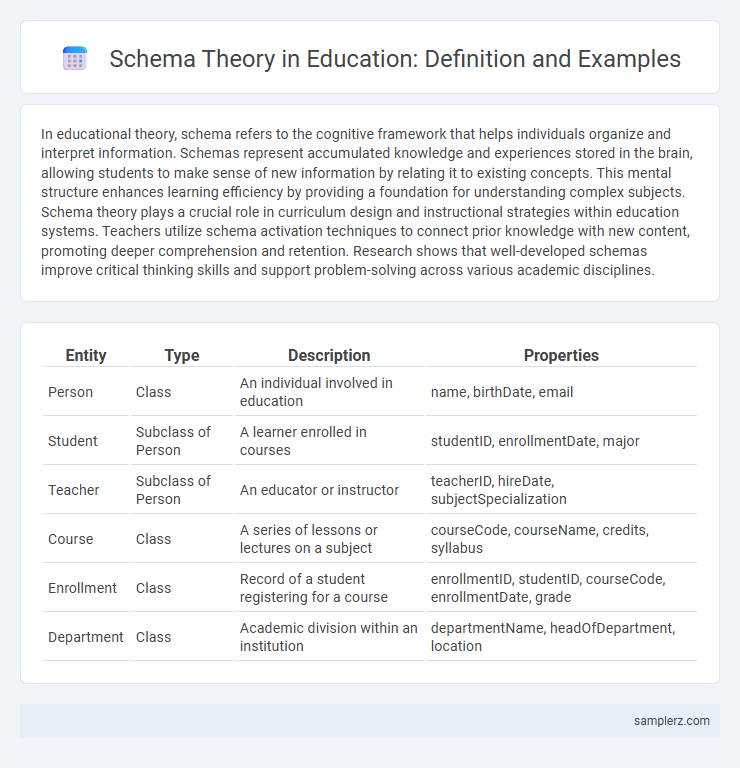In educational theory, schema refers to the cognitive framework that helps individuals organize and interpret information. Schemas represent accumulated knowledge and experiences stored in the brain, allowing students to make sense of new information by relating it to existing concepts. This mental structure enhances learning efficiency by providing a foundation for understanding complex subjects. Schema theory plays a crucial role in curriculum design and instructional strategies within education systems. Teachers utilize schema activation techniques to connect prior knowledge with new content, promoting deeper comprehension and retention. Research shows that well-developed schemas improve critical thinking skills and support problem-solving across various academic disciplines.
Table of Comparison
| Entity | Type | Description | Properties |
|---|---|---|---|
| Person | Class | An individual involved in education | name, birthDate, email |
| Student | Subclass of Person | A learner enrolled in courses | studentID, enrollmentDate, major |
| Teacher | Subclass of Person | An educator or instructor | teacherID, hireDate, subjectSpecialization |
| Course | Class | A series of lessons or lectures on a subject | courseCode, courseName, credits, syllabus |
| Enrollment | Class | Record of a student registering for a course | enrollmentID, studentID, courseCode, enrollmentDate, grade |
| Department | Class | Academic division within an institution | departmentName, headOfDepartment, location |
Understanding Schema Theory in Education
Schema theory in education emphasizes the role of prior knowledge structures, or schemas, in shaping how students comprehend and retain new information. For example, when teaching a history lesson on the Industrial Revolution, educators can activate students' existing schemas related to technological change or social transformation to facilitate deeper understanding. This approach supports scaffolded learning by linking new content to familiar concepts, enhancing cognitive connections and retention.
Key Components of Schema Theory
Schema theory in education emphasizes the role of organized knowledge structures, called schemas, that help learners interpret and store information efficiently. Key components include schema activation, which connects new information to existing knowledge; assimilation, where new data fits into pre-existing schemas; and accommodation, the process of modifying schemas when encountering novel information. These components enable deeper comprehension and facilitate effective learning strategies.
Classic Examples of Schema in Learning
Classic examples of schema in learning include Piaget's theory of cognitive development, where children build mental frameworks to understand new information. In language acquisition, schemas help learners connect vocabulary and grammar rules to real-world experiences, enhancing comprehension. Educational strategies often use schema activation by linking new content to students' prior knowledge, improving retention and critical thinking skills.
Schema Activation in Classroom Settings
Schema activation in classroom settings involves engaging students' prior knowledge to enhance comprehension and learning retention. Teachers use techniques such as concept mapping, questioning strategies, and real-life examples to connect new information with existing cognitive frameworks. This method improves critical thinking and aids in scaffolding complex topics across subjects like literacy, science, and social studies.
The Role of Schemata in Reading Comprehension
Schemata in reading comprehension function as cognitive frameworks that organize prior knowledge, enabling readers to interpret and predict textual information efficiently. For example, a reader with a well-developed schema about wildlife can better understand and integrate new information from a text about animal migration patterns. This schema-driven process enhances comprehension by activating relevant background knowledge and facilitating connections within the text.
Schema Theory and Prior Knowledge
Schema Theory posits that learners use prior knowledge frameworks to interpret and assimilate new information more effectively. Prior knowledge activates existing schemas in the brain, enabling the organization and integration of new educational content. Effective teaching strategies leverage this theory by connecting new material to students' pre-existing cognitive structures, enhancing comprehension and retention.
Illustrative Case Studies of Schema in Practice
Illustrative case studies of schema in education highlight how students use prior knowledge frameworks to comprehend new material, such as linking historical events to existing cultural understandings. Teachers implement schema-based instruction by activating relevant background knowledge through concept maps and guided questioning, enhancing cognitive connections. Research demonstrates schema activation improves reading comprehension and problem-solving skills by organizing information within meaningful mental structures.
Advantages of Schema-Based Instruction
Schema-based instruction enhances learning by organizing new information into existing cognitive frameworks, which improves comprehension and retention. It promotes active engagement and critical thinking by helping students relate concepts to prior knowledge, facilitating deeper understanding. Research shows that schema activation boosts memory performance and supports transferable skills across subjects, making instruction more effective and efficient.
Challenges in Applying Schema Theory
Challenges in applying schema theory in education include students' varying prior knowledge, which affects the activation and construction of new schemas. Inconsistent or incomplete schemas can lead to misunderstandings and difficulties in integrating new information effectively. Teachers must design instructional strategies that accommodate diverse schema backgrounds to enhance comprehension and retention.
Future Directions for Schema Theory in Education
Future directions for schema theory in education emphasize integrating artificial intelligence to personalize learning experiences based on individual cognitive schemas. Advances in neuroeducation provide new insights into how schema activation enhances memory retention and critical thinking skills. Implementing adaptive technologies tailored to learners' existing schemas can optimize instructional design and promote deeper conceptual understanding.

example of schema in theory Infographic
 samplerz.com
samplerz.com